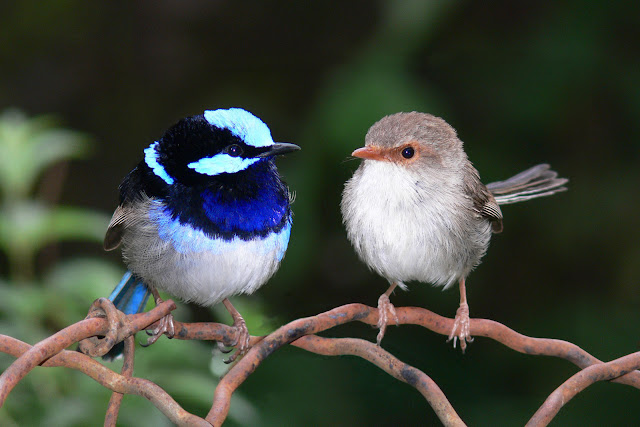 |
| Extreme sexual dimorphism is displayed in the Golden Pheasant (Chrysolophus pictus) - the male (rear) being spectacularly ornamented, while the female (front) displays drab colouration and a smaller body size. Photo by Kimball Chen http://keaphotography.photoshelter.com/image/I0000F1Owdy4Zd9U. Viewed on 18th March 2017. |
 |
| Mandarin Ducks (Aix galericulata) are another great example of sexual dimorphism in birds - the male (left) has striking ornamentation compared to the female (right). Image sourced from https://en.wikipedia.org/wiki/Mandarin_duck. Viewed on 19th March 2017. |
The general trend when it comes to sexual dimorphism is that males often display much brighter plumage and/or are larger in size than their female counterparts. Darwin (1871) and Wallace (1889) initially put this down to differences in social mating systems and paternal care, with polygamy causing the competitive sex to become larger and more ornate than the choosy sex and the sex that provides the parental care to develop more cryptic plumage (Owens & Hartley 1998). But if this is strictly true, why do we see socially monogamous species exhibiting biparental care that are highly dimorphic?
While size dimorphism displayed in some species of birds can be largely accounted for by the traditional idea of intrasexual competition, polygamy and differences in parental care (Darwin 1871, Owens & Hartley 1998, Wallace 1889), plumage dimorphism in socially monogamous birds is a more contentious issue. It has now been suggested that plumage dimorphism in socially monogamous birds may be due to extra-bond copulations (this is when despite having one partner whom each bird rears their young with, both males and females copulate with other individuals) (Owens & Hartley 1998, Webster et al. 2007). Molecular techniques have shown that up to 65% of socially monogamous birds display extra-bond fertilisation (Owens & Hartley 1998). If the extra-bond copulations that result in fertilisations are not random, which is almost certainly the case, then sexual selection should occur and favour traits displayed by males that are preferred by the promiscuous females (Owens & Hartley 1998, Webster et al. 2007).
 |
| The Superb Fairy Wren (Malurus cyaneus) is a great example of sexual dimorphism - the male's (left) vibrant blue plumage is strikingly different to the dull grey/brown plumage of the female (right). They are a socially monogamous bird but are known to be extremely promiscuous!. Image sourced from https://en.wikipedia.org/wiki/File:Male_and_female_superb_fairy_wren_edit21.jpg. Viewed on 19th March 2017. |
Just to make things more complicated, support has been growing for the idea that Wallace (1889) originally favoured - that plumage colour dimorphism is driven by the parent who primarily cares for the young, in most cases the female Owens & Hartley 1998) - but not how you think! Research into how hormones control sexual dimorphism in birds has shown that in many species, the default plumage is actually the bright, showy plumage we expect to see in males (Owens & Hartley 1998). This means that plumage colour dimorphism, in at least some cases, is due to females actively trying to become more cryptic by suppressing the default bright, showy plumage (Owens & Hartley 1998). I never knew this and I think it is incredible!
 |
| The Eclectus Parrot (Eclectus roratus) displays a unique form of sexual dimorphism in that the female (right) is actually brighter and more conspicuous than the male (left). This is due to different selection pressures acting on each of the sexes (Heinsohn et al. 2005). Image sourced from https://en.wikipedia.org/wiki/Eclectus_parrot. Viewed on 20th March 2017. |
References
Darwin, C. 1871, The descent of man and selection in relation to sex. London: Murray.
Dunn, P.O., Whittingham, L.A. & Pitcher, T.E. 2001, "Mating systems, sperm competition, and the evolution of sexual dimorphism in birds", Evolution, vol. 55, no. 1, pp. 161-17.
Heinsohn, R., Legge, S. & Endler, J.A. 2005, "Extreme Reversed Sexual Dichromatism in a Bird without Sex Role Reversal", Science, vol. 309, no. 5734, pp. 617-619.
Owens, I.P.F. & Hartley, I.R. 1998, "Sexual dimorphism in birds: why are there so many different forms of dimorphism?", Proceedings of the Royal Society of London. Series B: Biological Sciences, vol. 265, no. 1394, pp. 397-407.
Wallace, A.R. 1889, Darwinism: An Exposition of the Theory of Natural Selection, with Some of the Applications. Macmillan.
Webster, M.S., Tarvin, K.A., Tuttle, E.M. & Pruett-Jones, S. 2007, "Promiscuity drives sexual selection in a socially monogamous bird", Evolution, vol. 61, no. 9, pp. 2205-2211.








